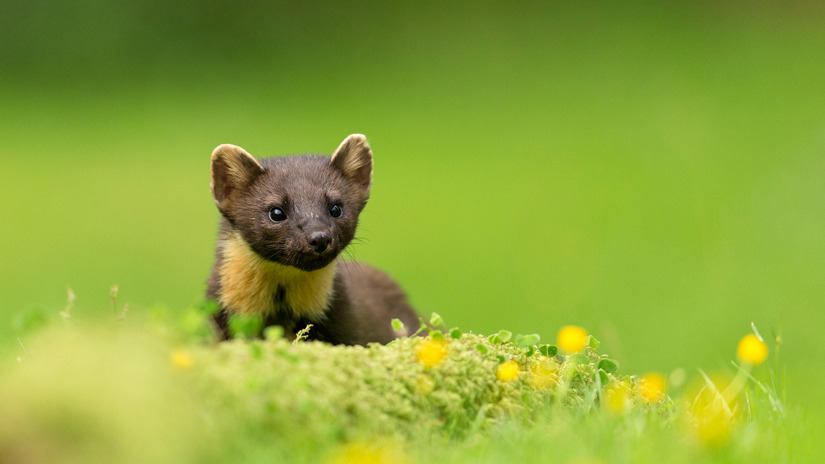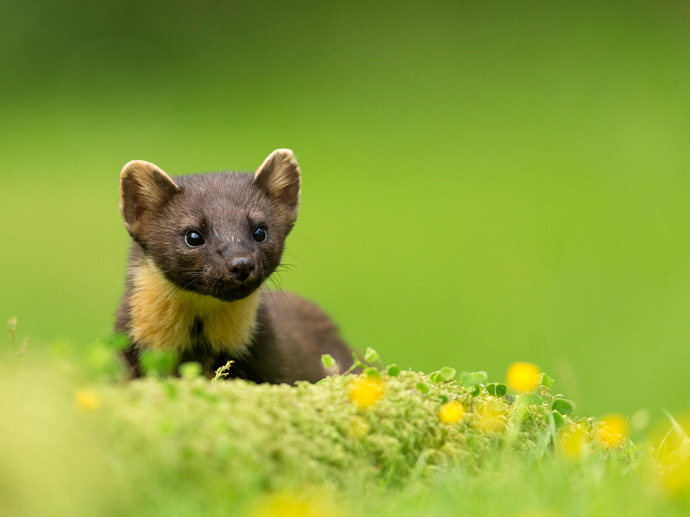Common name: pine marten
Scientific name: Martes martes
Family: Mustelidae
Habitat: native woodland, conifer plantations
Diet: small mammals, birds, fruit and invertebrates
Predators: fox, golden eagle
Shy, curious and playful. The pine marten is a stealthy, acrobatic hunter that relies on the cover of woods and trees for its foraging missions. It’s critically endangered in England and Wales as much of its woodland habitat has been lost.
Common name: pine marten
Scientific name: Martes martes
Family: Mustelidae
Habitat: native woodland, conifer plantations
Diet: small mammals, birds, fruit and invertebrates
Predators: fox, golden eagle
The pine marten has a long, lithe body with chocolate-brown fur and a pale-yellow patch around its throat. It has large, round ears and a long, bushy tail and is similar in size to a small domestic cat. It measures around 60–70cm and weighs approximately 1–2kg. Males are roughly a third bigger than females.
Not to be confused with: mink, weasel or stoat. All of these mustelids are roughly similar in appearance, so it can be easy to mix them up. Weasels and stoats are much smaller than pine martens, and the American mink is slightly smaller with much darker fur. Pine martens are much more likely to be seen in trees than any of those species.
Pine martens mainly eat small mammals, such as voles and mice, but can take prey up to the size of a hare. They will readily scavenge on carrion and also take birds and their eggs when the opportunity arises. Pine martens are not entirely carnivorous, as fruit and berries are readily eaten too.
Grey squirrels may also be on the menu for pine martens. There is evidence to suggest that the presence of pine martens reduces the numbers of these non-native rodents, which has a positive impact on the threatened red squirrel.
During the summer, around 30% of their diet may be made up of bilberries, turning their scats blue.

Credit: Ronald Stiefelhagen / Alamy Stock Photo
Pine martens are solitary creatures, only coming together during the mating season, in the summer. A sure sign that the mating season is in process is the sound of the shrill, cat-like ‘yowl’ that the pine marten makes.
Pine martens produce one litter per year, with the cubs normally born in March or April. After six weeks they will venture out of their dens, and are fully grown at six months old. Pine martens normally breed for the first time at around 2–3 years old.

Male pine martens can require up to 200 hectares of woodland for their territory.
As their name suggests, pine martens favour woodland habitats. Mature trees with holes and cavities are important for the species, as it uses these sheltered spaces to rest and raise its young. Pine martens can survive in more open country provided there is some degree of tree cover.
Once widespread across the UK, hunting and woodland clearance meant the species was restricted to just the Scottish Highlands and tiny pockets of Wales and northern England by the 20th century. Now legally protected, the pine marten population is spreading across Scotland once more, but remains very rare in England and Wales.


Charlie Mellor • 14 Jun 2018
They may look cute and cuddly, but with fierce teeth and claws and an appetite for small mammals, the elusive pine marten is anything but! Learn more about this iconic woodland species and how we're helping to secure its future.
Pine martens are notoriously difficult to spot as they are shy and primarily nocturnal. Visit the woods in summer for the best chance of spotting them, as females and their young can forage during the day at this time of year.
Even if you don’t see a pine marten in the woods, you might see signs of its presence. Pine marten scats (poo) are usually dark and coiled, and some contain lots of berries. They are very similar in appearance to fox scat; however they smell sweet whereas fox scat is quite pungent.
Looking for tracks or footprints is another way to detect pine marten presence. Their tracks have five toes and are around 5cm by 6cm in size. Listen out for the distinct high-pitched call of the pine marten during the summer, when the mating season is in full swing.

Pine martens are the only mustelids with semi-retractable claws.
Legal protection has allowed the Scottish pine marten population to grow, but it remains critically endangered in England and Wales.
We are part of the Pine Marten Recovery Project which aims to ensure the species’ survival outside of Scotland. More than 50 Scottish pine martens have been successfully relocated to the woods of mid-Wales and there are plans to reintroduce the species to the Forest of Dean. There is also evidence that pine martens are slowly making a natural return to northern England. Protecting the species’ woodland habitat will play a key role in supporting this recovery.
If you are lucky enough to spot a pine marten in England or Wales, please contact the Pine Marten Recovery Project.


Once persecuted to extinction, find out how we're helping pine martens make a welcome return to the UK's woods.

Woodland wildlife is fading before our eyes. Please support our appeal to save rare and threatened species.
Donate now